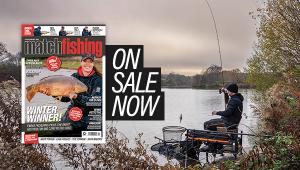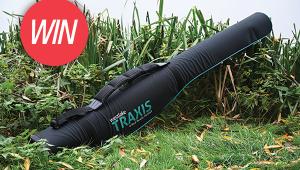The Chub Chaser
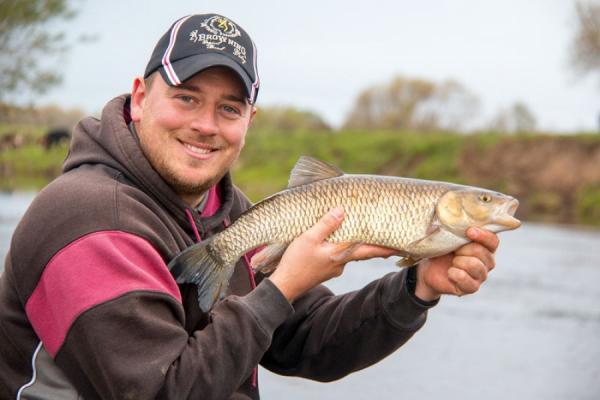
Well-known for his commercial exploits, Adam Richards has taken the decision to enjoy some proper river fishing… and he’s been learning fast!
In recent years I have fallen in love with proper, natural river fishing, and I mean rivers where there isn’t a pole in sight and the walks are long! Rivers such as the Swale in North Yorkshire, where we are today, have really captured my imagination and I’ve had some great results.
I guess the key for me is how stripped back the fishing is. You don’t need loads of gear and the entire match is based around trying to outwit the crafty chub that inhabit the river.
The appeal for me of a winter day’s chub fishing means that I rarely go on commercials during these colder months. Fishing for two or three chub seems far more appealing to me as you need to be busy all day long. I have found that the float (if conditions are okay) is the best tactic and I have tried to develop an approach that revolves around small wagglers and a refined bolo attack.
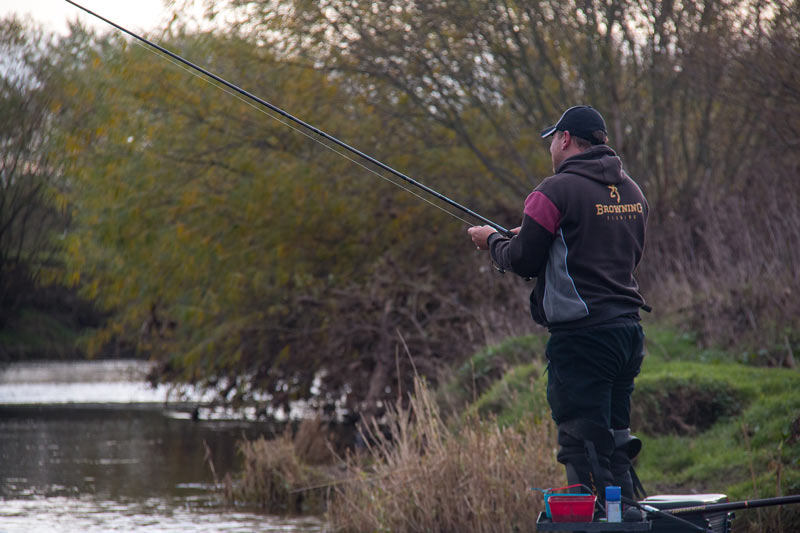
Watercraft Is Essential
You just never know what this river will give you. Each peg is so different; this is a wild venue that is fast and shallow. It’s feature packed too, but what this kind of river teaches you is watercraft like no other.
Today’s swim is a proper example of this and is also a classic Swale peg. Above me are some shallow rapids that run off with most of the flow alongside some very inviting looking trees. The flow then changes and actually moves into the centre of the river about 20 metres downstream, before running off into another rapids section.
The assumption would be that the treeline would be the best place to catch the fish. Yet amazingly the bulk of the fish are well down the swim in the centre of the river. The flow is slightly more even and less turbulent down there and it seems that today the fish are happiest there.
What this swim does offer though, is a lovely big slack on the other bank. I can imagine that with extra water the fish will hang out in that area. However on a low, clear river like today that area may not hold many fish at all.
The Setups
I like to set up the waggler and bolo as they both have their strengths and weaknesses. The waggler is superb for searching the swim to find where the fish are. It’s a little easier to fish and the waggler will fish itself more, allowing you to keep feeding and searching the swim.
Once the fish are found then I don’t think the bolo and its precise presentation can be beaten. I can do a lot more with the bolo: I can run it through at the pace of the river, slow it down and inch it through, hold it back hard to lift the hook bait before running it and I can even back wind the float down the swim.
The bolo gives me so much control and I have found it deadly for these wily chub.

For the waggler I use the lightest and shortest float that I can get away with. A small truncheon design is ideal in this fast water. A 2AAA model is today’s choice, as it doesn’t make much disturbance when it is cast and thanks to the fat top I can drag line on the bottom and the float won’t drag under.
I keep the waggler setup simple and don’t use any shot down the line at all. The float is attached to the line using some gripper stops and a swivel. The waggler is then attached using a short link of 6lb mono to which the shot are attached. I do it this way so that I don’t have any large shot on the reel line that could potentially cause damage.
The bolo is simple too but features a couple of key tweaks. I am using a 2.5g body-up float but the key difference is I have shortened the bristle and stem to make the float more discreet in swims that could only be two feet deep.
This is shotted with a bulk 15 inches from the hook with no droppers below. I want the hook bait to have some freedom below the bulk and having no droppers at all allows the hook bait to behave relatively naturally.
Both setups feature 0.15mm Cenex main line and either a 0.13mm or 0.15mm Cenex Fluoro Carbon hooklength. It’s worth noting that I won’t hesitate to fish straight through. Hook choice is a size 16 or 18, perfect for using two or three maggots.
The waggler is set up using the new 13ft 6in Browning Sphere Spliced-Tip while the bolo utilises the extra length of the 15ft 6in model. The spliced tips, combined with the light and responsive Sphere blanks, make these rods perfect for this style of fishing.
Feeding
When the all-in is called I actually don’t start fishing. I prefer to loose feed for at least 30 minutes before wetting a line. In my experience the worst thing you can do is catch a chub first cast as often the fish will spook and never return. Bear in mind that five bites is often the target to win some money, as these are big fish. Although a winning weight is likely to be between 40lb and 80lb!
I rely on two baits: maggots and hemp – classic fare. The hemp is only used in certain situations and can be very helpful when minnows are a problem, although they vanish in the winter.
River matches here and on other smaller rivers in Yorkshire throw up a unique situation in that you draw a swim rather than a peg. That could mean the next angler is a long way from you and you are actually allowed to move down towards him as the match goes on. The hemp is useful in this situation as I often put a pint or so next to a feature downstream for later on in the match; I can then walk down there and try it for a bonus fish or two.
Maggots though, are my firm favourite. I can feed up to six pints in a match but usually three pints are enough. The Swale offers quite a unique scenario as you are only fishing for chub. There are hardly any roach, dace or perch here and only the occasional barbel, but 90 per cent of the time it’s chub or bust. Chub absolutely love bronze maggots and I am only too happy to give them plenty. I see no need to feed cautiously.
Presentation Matters
Today I am only expecting to catch two or three chub. The water is icy cold and there is even the hint of some snow in the air. On days like this, the bolo really comes into its own.
The chub may not feed too aggressively on days like today and having the ability to slow that hook bait down can score. I really like to concentrate when fishing like this and I also like to experiment. I am constantly switching things up so that no two runs through are the same. However, after a couple of fish, it’s obvious that the fish are responding to the bait being slowed right down.
The bites have come down the middle of the river and I’m finding that when I reach the ‘killing zone’ it’s best to hold the float back hard for a few seconds before releasing the float back to full pace. The bites I’ve had have been immediately after holding the rig back.
Back winding is a deadly way of presenting a bolo and allows for incredibly smooth and controlled presentation. I like to cast well downstream and get the float going through, then click the bail arm over and slowly back wind down the swim. You may need a slightly heavier float for this to give you that perfect control. Today though, with little wind I can perfectly control the light 2.5g bolo. This approach can take some practice but back winding will catch you more fish so it’s worth getting out and giving it a go.
Three Bites – Success
Today has been a tough session but is a realistic representation of what can happen on a tough winter match, especially where chub are concerned.
It has taken nearly two hours of feeding and mixing up the presentation before finally nailing the first fish. I’ve ended with three fish for around 12lb, which I wouldn’t be unhappy with on a difficult day.
Undoubtedly the key lessons from today are just how important it has been to slow the float right down – almost walking the hook bait into the chub’s mouth. I think when the water is as cold as it is today, being open to really concentrating on your presentation will make you a better river angler.
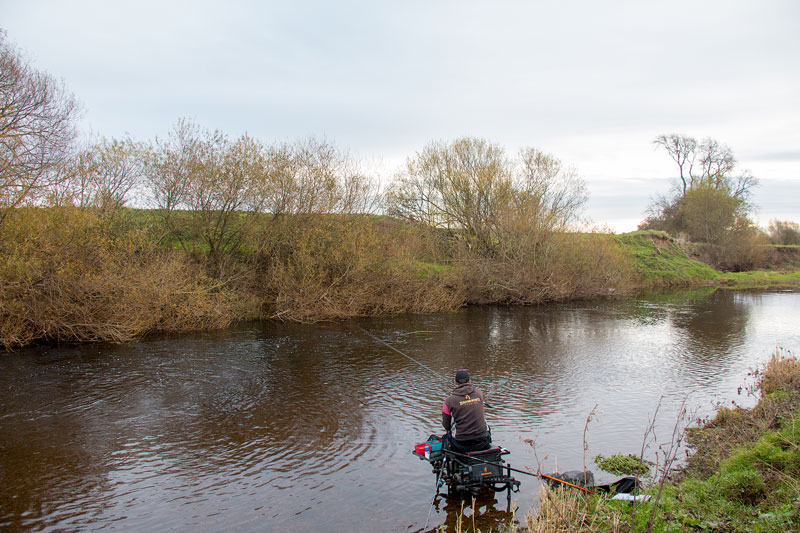
River Swale
Morton-on-Swale
Northallerton Angling Club
www.nadac.org.uk
Adam Richards
29
Easingwold
Browning
- Log in or register to post comments






